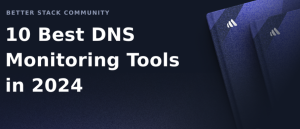Top DNS monitoring tool options will be discussed in this article. Your quiet assumption that the DNS provider hosting your domain names will happily reroute traffic to your server is probably correct. I don’t want to disturb your peace. Still, you need to be patient and trust your DNS provider because there are risks that can compromise it and performance issues that can degrade the visitor experience on your website.

A global hacking campaign began about a year ago to target DNS servers with a specific vulnerability. As a result of the attack, many DNS servers are now routing traffic to rogue websites although the flaws were later fixed, the attack served as a wake-up call to all network managers and website owners to check their DNS infrastructure.
As a result, DNS monitoring tools have become essential to maintaining any IT system, regardless of its design or intended application. Before we get into DNS monitoring, let’s define what it means to assign a domain name to a DNS provider. DNS records, or files, map domain names to specific IP addresses. These files are stored on the name server. Additionally, root name servers located around the world record the locations of top-level domains such as .com, .org and .eddo.
Each TLD specifies a number of servers that monitor where each domain’s DNS records are stored; these servers are often DNS providers or registrars such as Go Daddy or Namecheap. These are the authoritative servers for domain names. When you add a domain name to a DNS provider’s servers, those servers become authoritative for any queries that refer to the new domain.
Following this presentation, it is clear how important DNS is to network efficiency and how it serves as a breeding ground for security problems. As the first point of contact between end users and their services, a reliable DNS monitoring service is essential to ensure DNS availability and performance, two requirements for which you are responsible.
What Does DNS Monitoring Do?
To frequently evaluate DNS server stability and stay up-to-date on any changes to the DNS system, you must monitor the DNS provider that maintains your domain names. By adopting this, you will be notified about potential site attacks or when an inconsistent or problematic DNS is harming your site’s overall performance.
DNS monitoring tools evaluate communication between domain name authoritative name servers and recursive name servers, which act as cache memory to speed up the name lookup process. This test can be done manually or automatically at regular intervals. When the test is done automatically, the tool will notify you about the results. These tools can also be used to compare services from different providers or to verify a DNS service provider’s service level agreement.
A DNS monitoring service must verify the ability of the DNS service to return the correct set of IP addresses until it reaches the root DNS server. This enables it to detect DNS spoofing and hijacking attempts, a DNS flood is another type of attack; to detect one, a DNS monitoring tool should detect DNS slowdowns and alert the network administrator when a flood attack is possible. Every DNS monitoring service should fulfill these basic responsibilities, but the various solutions available offer several additional features that must be evaluated to choose the best one. Let’s take a look at some of the best DNS monitoring tools available today.
Top 12 Best DNS Monitoring Tools Options in 2024:-
We’ve compiled a list of the best DNS monitoring tool options to help you choose the best one.
Zone Watcher:-

Zone Watcher automates DNS monitoring, reporting and backups. With our DNS monitoring tool, you’ll always have a backup copy of your DNS records in case something goes wrong or unexpected changes occur. It has a sophisticated change log that allows you to see the complete history of changes in a region. Zone Watcher, which is primarily intended for commercial use, allows you to monitor domains from multiple providers if you deal with a large number of customers. Divide monitoring staff by managed items, allowing you to create teams. Data can be exported as zone files and/or accessed via a REST API, allowing your application to interact with the data. Alerts may be provided by email.
Uptrends:-
We understand that simply monitoring your IP address will not enable you to identify every possible DNS problem. Uptrend provides external DNS monitoring, which tracks all required DNS records from Checkpoint’s global network. The Uptrends service monitors DNS zone representatives, SMTP mail server mappings, aliases, and SOA numbers in addition to DNS A records and AAAA records. To avoid downtime, alarms are sent across multiple channels as soon as DNS problems occur, enabling you and your team to respond quickly. In addition, Uptrends can provide you with reports with critical information, such as the number of DNS servers collected from around the world and their performance.
Statues Cake:-
Due to the timely notification of Status Cake domain monitoring tool, squatters cannot take over your domain and harm your organization if you fail to renew it on time. You can also monitor changes to your DNS records. Stats cake offers three options, including a free one with some limitations and a 5-minute trial window. Membership options offer a free trial period and include additional services such as SMS notifications, 30-second test intervals, and team tools.
DNS SPY:-
DNS Spy is designed for those who are concerned about the security of their DNS. As the name suggests, it focuses only on DNS monitoring. To test it, just add your domain and wait for the service results with warnings and suggestions for each reported item, the system will automatically discover all relevant DNS entries and provide a detailed report describing connectivity, performance, security, resilience and coverage issues.
The comprehensive monitoring service not only keeps a complete history of changes and backs up your DNS records in case you need to restore them, but it also sends notifications whenever a record changes. It also checks that all your name servers are in sync and alerts you to any incorrect or RFC-incompatible setups. The pricing plan is divided into three categories, each covering a different number of domains.
App Neta:-
AppNeta’s approach to DNS monitoring, adaptable to any network architecture, is particularly well-suited for enterprises moving to the cloud. It employs a comprehensive monitoring engine that covers a wide range of servers, both internal and external, and collaborates with several ISPs and DNS providers. AppNeta stores data for a full year at no extra cost. By analyzing the data you can see how DNS resolution affects the user experience of your application. You can search for patterns of performance spikes or detect worsening trends in performance the monitoring service includes application context in its reports to help IT professionals uncover DNS resolution issues related to application issues. AppNeta’s network performance monitoring capabilities are closely tied to DNS monitoring.
Site 24×7:-
Site24x7 provides a unified monitoring solution for servers, public and private clouds, websites and applications. Website monitoring system additionally checks FTP, SSL, SMTP, POP, URL, API, HTTPS protocol and DNS services. It provides comprehensive reports including alarms, screen recording and second check from multiple locations. Services can be monitored over Internet, Intranet, and Wi-Fi and 3G/4G networks. DNS Monitoring, for example, provides detailed bottleneck and performance statistics and classifies end-user experiences as happy, neutral or unhappy. Alerts and notifications can be sent via voice call, SMS, email, Twitter, RSS feed or push mobile notifications.
DNS Check:-
DNS Check provides a DNS-only monitoring solution. It often monitors DNS records and name servers for lookup errors or changes and tells you if any changes are detected. You can enter the DNS entries you want to monitor or import the entire zone file into the system.DNS Check allows you to offer a URL that specifies which records to change and notify you whenever updates are detected. DNS checks help determine if a DNS problem exists for diagnostic and troubleshooting purposes. DNS Check can be used for free if you want to monitor 10 domains. If you want to monitor more than 10 domains, consider a subscription package.
Sucuri:-
Sucuri provides DNS monitoring services as part of its website security platform. Only enabling website malware detection in Sucuri UI will enable these services the monitoring service generates alerts when DNS record changes occur. Sucuri monitoring solution notifies you when you’re DNS go down is changed unintentionally, or hackers change your DNS with malicious intent. Scanning frequency can be adjusted using the Sucuri dashboard to meet your needs. You can choose to receive notifications via email, SMS, Slack or RSS. Additionally, email reports provide a lot of information for forensic studies.
Dotcom Monitor:-
Dotcom-monitor’s enterprise-level DNS monitoring ensures DNS availability and performance from over 30 global monitoring sites while providing rapid alerts. You can see the performance statistics. Lazy performance is directly caused by lazy DNS resolution, which can be very costly for organizations. When a problem occurs, dotcom-monitor, unlike other DNS monitoring tools shows the entire DNS propagation path, enabling you to immediately identify the source of the problem.
Catch Point:-
Catch point’s DNS monitoring tool provides a realistic view of DNS performance by accessing hundreds of vantage points from a variety of providers, including backbone, cloud, last mile, Internet and wireless. By establishing the cause of failure for each server in the DNS route, it is possible to verify true DNS speed, reliability, reach ability, and availability, therefore aiding in troubleshooting and isolation. Catch point analyzes the performance of DNS caches and well-known DNS resolvers by identifying misconfigured name servers in your resolution chain. The technology detects abnormal response times and detects potential attacks by monitoring DNS servers. DNS Performance Monitor monitors your DNS provider and lets you compare providers to find the best option for your migration.
Paesslar PRTG:-
Paessler AG’s network monitoring software, PRTG, provides unified monitoring of bandwidth, servers, applications, network devices, virtual environments, Internet of Things, remote systems and other components. DNS monitoring tools, in particular, monitor the performance and availability of your DNS servers, provide detailed information and notify you immediately in case of problems or outages.
The company has six distinct pricing tiers, which vary in the number of sensors that can be installed and the number of servers that can host them. PRTG enables you to monitor various properties of a device including sensors. Examples include the amount of traffic flowing over a network connection, a specific URL, a switch port, or a computer’s CPU load. Users can easily customize the system to monitor anything they need by licensing the number of sensors instead of the number of devices.
Nagios:-
Both Nagios XI and Nagios Core, well-known monitoring systems used by millions of consumers and thousands of enterprises ranging from Fortune 500 corporations to small business owners, provide DNS monitoring. Using Nagios to monitor DNS servers, protocols, and queries can help you improve the availability of servers, services, and applications, discover network failures and protocol problems, and quickly detect DNS hijacking and spoofing. Third-party components, such as Nagios Exchange plugins and wizards, can be integrated into the Nagios monitoring system. The basic system benefits greatly from these upgrades, which include advanced reporting capabilities, mobile log access, in-depth analytics, and other unique features. Nagios also monitors protocols other than DNS, including SNMP, HTTP, SSH, FTP, and SMTP.
